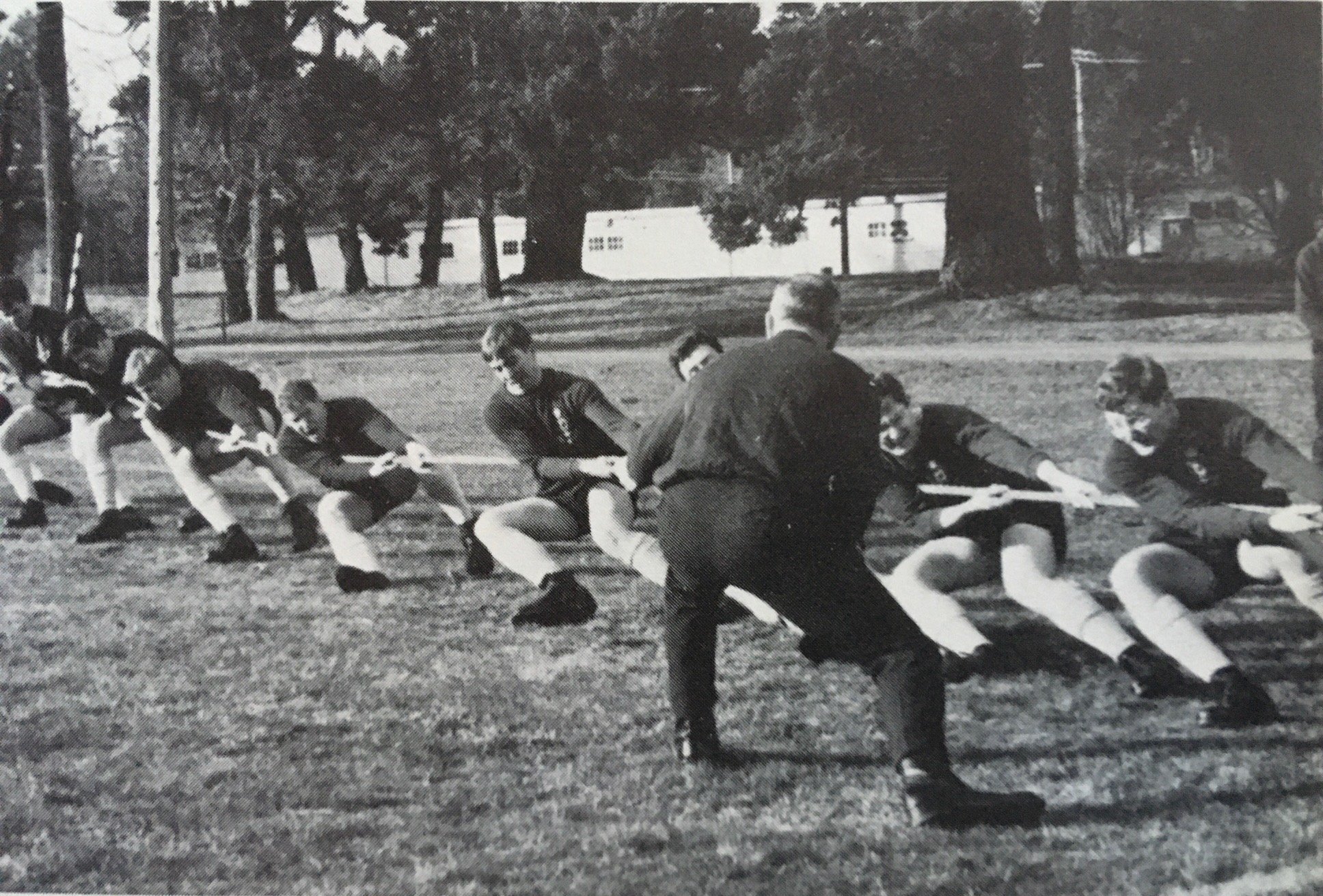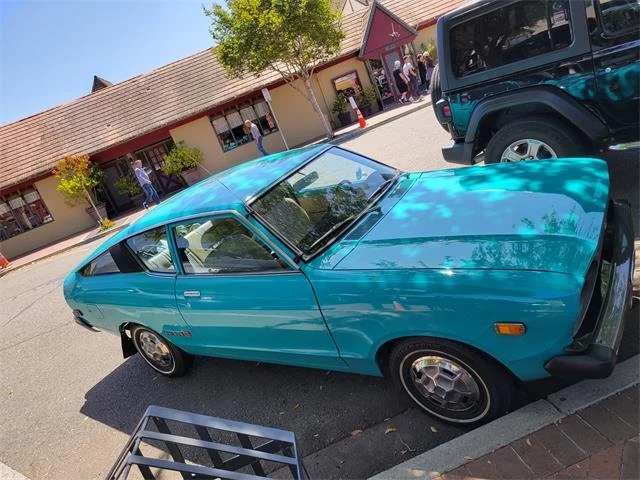With Thanks to 12352 Chris “chwlyms” Willmes
Major brodsky
In my first year at Royal Roads, I was very reserved, too much so for my CFL’s liking, so he was on the lookout for a suitable “opportunity to excel.” Serendipity came to the rescue. It just so happened that another newcomer to the college that autumn was a real hard-core infantry major by the name of Brodsky. He was a graduate of the US Army’s gruelling Ranger School, and at Roads, he was a prof in the English Department. He had a passion for the literary works of merchant mariner and novelist Joseph Conrad, and also for the relatively obscure sport of tug-of-war.
Shortly after his arrival at Roads he decided that what the college was lacking was a tug-of-war demonstration team. Nearly four dozen of the Wing’s brawnier cadets responded to the major’s recruiting drive. By dint of a particularly gruelling training regimen, he quickly winnowed the group down twenty, and then to a baker’s dozen.
But he was in need of a team manager, i.e., a gopher. My CFL quickly volunteered the services of yours truly. There was nothing “excelling” about the job; my principal contribution was hauling the machine used for marking the playing fields down below the castle up to the empty field near the guard house that we were using for training, and marking out a tug-of-war pitch. (Having the key to the shed where the machine and bags of lime were stored was to come in handy when the Cadet Wing raided the University of Victoria; see “In the Lime of Duty”,
https://www.tdv79ers.ca/classmates/anecdotes/skylarks/roads-memories-in-the-lime-of-duty
The tug-of-war team. Major Brodsky is on left flank, the Johnston twins are in the front row, on the left, and Walt Natynczyk and Jim Manton are in the back row, on the right.
One afternoon at the conclusion of practice, the major told me that the team needed a uniform; nothing extravagant, just a sweatshirt with the college badge and the words “Tug-of-War” silkscreened onto it. These were pre-Internet days, so I couldn’t just go online to find a supplier of suitable, affordable sweatshirts, and a reasonably-priced print shop. I had to resort to thumbing through the Yellow Pages and using that archaic communications device, the telephone (with a rotary dial!). By the time of the next training session, I had it all sorted out, but there was a small matter of transportation; I needed to go into Victoria to buy the sweatshirts and deliver them to the print shop, and then at some later date I would need to go back into town to pick up the finished sweatshirts and bring them back to the college. From Royal Roads to downtown Victoria is about a dozen km, and back then there was no bus service, and taxis were expensive. I needed a car, but as we first years weren’t yet allowed cars, I couldn’t just borrow one from one of my peers. Borrowing a car from a senior was out of the question; the rigorous indoctrination of recruit camp was only a few weeks in the past, and still deeply seared on my psyche was the maxim, “seniors are NOT your buds!” Oddly enough, I had absolutely no qualms about asking the snake-eating Airborne Ranger if I might borrow his car.
Datsun B210, the official car of not having anything as standard equipment
I explained the situation to the major, and then I asked if might borrow his car to run my errand. Without a moment’s hesitation — obviously impressed by my diligence, organization, and initiative, or maybe it was just my impudence — he reached into his pocket, withdrew a set of car keys, and told me that his was the green Datsun B210 parked behind Grant Block. The car was actually turquoise, but no self-respecting, snake-eating Airborne Ranger was going to admit that. I held my hand out for the keys, but the major paused and asked me, “you do know how to drive a standard, don’t you?” Of course I did, and I told him so.
I ran back to Nixon Block, changed into my sixes, then ran back over to the parking lot behind Grant Block, and found the major’s car. I got in, and briefly surveyed the instruments and controls. They were elemental in the extreme, even by the spartan standards of late seventies Japanese automobiles. I inserted the key in the ignition, gave the handbrake lever a tug to make sure that it was engaged, moved the gear shift lever into neutral, pulled out the choke, depressed the clutch pedal, and then turned the ignition key. The little 1.4 litre four-banger started right up. I gently let out the clutch and let the engine idle for a few moments, while I contemplated my next move.
The motto of the Canadian military colleges is “Truth, Duty, Valour” and strictly speaking, I had told the truth when I answered “yes” to the major’s question as to whether I knew how to drive a manual transmission. At the ripe old age of eighteen, I had known how to drive one for years. I had read all about it, and I had watched my dad drive a stick countless times; while all of the cars I recall him owning were automatics, every time he dropped off the family wagon at the local garage for maintenance (and as he had a predilection for Fords, that was often) he would always take a car with a manual transmission as a loaner. While I had never actually driven a car with a manual transmission, I was fully versed in the operating principles.
The engine was adequately warmed up, so I pushed in the choke, and looked around in preparation for getting underway. Disengaging the clutch, I selected reverse gear, and having determined that there were no other cars or pedestrians nearby, I released the handbrake and gingerly let out the clutch. And promptly stalled the engine. I had neglected to apply a soupçon of throttle as I engaged the clutch. I quickly scanned my surroundings; no one had witnessed my little faux pas. I repeated the starting drill, less the choke, and tried once more to move the car. This time, I was able to back out of the parking spot successfully, albeit somewhat jerkily. Encouraged by this minor triumph, I disengaged the clutch, selected first gear, released the clutch, and… stalled again. If you’re not making mistakes, you’re not doing anything, I told myself, and I restarted the car. This time I was able to get the car underway, with only a minimum of lurching. I drove the length of the parking lot and turned to pull out onto the road that led to the guard house. As I waited for some crossing traffic to pass, I looked up the road in the direction of the guard house. And by “up” I mean “up hill”; the parking lot from which I was exiting was about halfway up a long, steep hill that started down at the lagoon and ended by the team’s practice field; I’m not sure what was the difference in elevation (surveying the college grounds was a second-year engineering project), but it was a lot. Climbing this hill in this little car with its sixty-nine snarlin’ horses and my nascent manual-transmission driving skills was going to be a challenge. If I stalled on the hill, I would be in trouble. I was familiar with the whole holding-and-then-releasing-the-handbrake-while-simultaneously-engaging-the-clutch-and-pressing-the-accelerator concept for starting on a hill, but at this early juncture in the development of my stick-driving skills, I was just barely managing the coordination of clutch and throttle. I briefly contemplated turning the car in the opposite direction, driving down the hill, turning around at the boathouse on the lagoon, and then driving all the way back up the hill. But God hates a coward, I reminded myself. Fortune favours the bold. And what if I got stuck down at the bottom of the hill? The major would be… disappointed. And I didn’t care to think about the consequences of that. I figured that if I was going to get stuck on the hill, I would do it right here. I revved up the engine, rather more than was necessary, and let out the clutch. The parking lot was unpaved; the rapidly spinning rear wheels flung gravel rearward, and the car fairly leapt forward onto the road. I managed not to lose control and go careering off into the trees on the far side of the road; instead I got the car pointed up the hill. I drove steadily upwards, pressing hard on the accelerator. The engine was roaring, in its anemic fashion, and I knew that I should probably shift into second gear, but I hadn’t yet attempted to shift gears while the car was moving on level ground. What if I missed second gear on this hill? What would the major say if I rolled his car backwards all the way down the hill and into the lagoon? I gritted my teeth and pressed on. After what seemed like an eternity, the car crested the hill. Emboldened by this achievement, I shifted the transmission into second gear. It wasn’t a smooth shift, far from it, in fact, but at least I didn’t grind the gears. I cruised past the field where the tug-of-war team was practicing; feeling increasingly confident in my fledgling skills, I beeped the horn, and waved to the major.
I was fast approaching guard house, and the stop sign just beyond. I downshifted into first gear, but my attempt at rev-matching was abysmal. The engine raced, the rear tires chirped, my foot slipped off the accelerator, and the engine nearly stalled. This time, my ineptitude had a witness; the commissionaire at the guard house looked at me with disdain. I pulled up to the stop sign, and waited for an opening in traffic. Then I pulled out onto the highway, almost like I knew what I was doing. Accelerating, I shifted into second gear, much more smoothly than the first time. And then into third. I was getting the hang of this! By the time I got to downtown Victoria, I was up-shifting and down-shifting quite handily, if not altogether smoothly. (I have no doubt that the paucity of ponies under the hood made the learning much, much easier.)
I located the store from which I had ordered the sweatshirts, picked up the merchandise, and then delivered them to the print shop. My errand complete, I drove back to the college, shifting gears with ever-increasing facility and confidence. I arrived just as the team was finishing their practice, so I stopped by the side of the road to report to Major Brodsky, and return his keys to him. He asked me if I had had a successful errand. I replied that everything had gone smoothly. He looked at me askance, ever so briefly; had he witnessed my inept downshift during my departure earlier? “Okay” he said. “Let me know when you need to go pick up the sweatshirts.” A week later I borrowed the major’s car again to collect the sweatshirts from the print shop. By the end of that trip, I was rowing through the gears like I had been born to it.
I borrowed the major’s car on several other occasions, running errands for the team. If ever Major Brodsky figured out that I had never actually driven a manual transmission-equipped car before driving his, he never let on. Maybe he was loathe to admit that he been flummoxed by a first year. All the same, I never signed up for any of the major’s classes, lest something I said in class, or wrote in an assignment, triggered a repressed memory…



